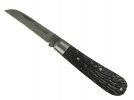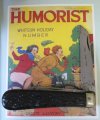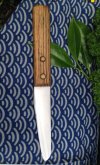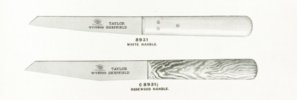Reading this great thread with so much wonderful information from Jack, Cambertree, and others has forced me off the couch and onto the porch. Upon going through the recent discussions it led me to investigate the Sheep Foot and Lambs Foot models from an American perspective. While clip and spear point blades have certainly dominated over others in the United States since early on, Lamb Foot blades have been there along side the more common blades. Congress patterns have been seen more than any others with Sheep Foot blades and enclosed is a picture of a "Northfield Knife Co." Congress pattern knife from 1865 with two Sheep Foot styled blades. After going through many American knife company catalogs, it appears that U. S. cutlery makers often used the term "Sheep Foot", but not "Lambs Foot". The smaller Lambs Foot blades were just incorporated under the name "Sheep Foot". Also interesting are the many different uses for a Sheep Foot blade in America and several are shown below which include, "Scout Knife", "New England Whaler", "Barlow", "Horticultural", and "Cattle/Stockman". Needless to say that the Sheep Foot blade has thrived in the United States since the early days of American cutlery.
Great to see you here my friend, it's been too long

Yes, the Sheepsfoot blade has been seen in the US for a long time, as evidenced in these photos of knives taken from the
Arabia steamboat in 1856.
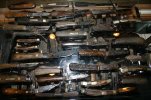
We also see among these knives, a couple of Barlows with the 'Short Beak' blade, similar to those seen in
Smith's Key of 1816.

Coping blades have also been common.
Aside from the taper from tang to tip, they are very similar. Both are very useful. I wonder if the taper on the lambsfoot may have some ergonomic advantage since the handle will be slightly raised (for a more natural grip) when the edge is parallel to cutting surface --just speculation though.
I find both Sheepsfoot and Lambsfoot blades useful for different jobs. The slimmer blade profile of the Lambsfoot is useful, but so is the (generally) steeper angle of the point. In terms of the development of the blade, it may also be worth considering that both Sheepsfoot and Lambsfoot knives may have been built by cutlers on the same frame (as is the case at A.Wright's today I believe), which means that the width of the different blades would have to be the same, or similar at the tang (and only at the tang). By adding a taper to the Lambsfoot, you get a knife with a narrower point than the Sheepsfoot, but retain much of its strength, and you have the versatility of being able to use an existing frame.
Thanks supratentorial. Yes, the American Sheep Foot blades tend to run parallel from tang to tip as opposed to tapered on many of the Sheffield blades.
Don't Sheffield Sheepsfoot blades also run parallel?

Sheepsfoot and coping blades run parallel, classic Lambsfoot blades have a taper.
Northfield is a particularly interesting example as they employed many migrant English working cutlers who, I understand, arrived in the US during the 1840s and '50s.
As one could reasonably expect that they would have brought with them working knowledge of all the patterns that were in vogue at the time in Sheffield - and to have produced them for Northfield and Waterville Cutlery Co., perhaps you have found an early cut off point - and the Real Lambsfoot with tapered spine may have come after that time.
That's an important point I think Chin, and adds to the argument that the Lambsfoot pattern developed slightly later

Jake, yes I think you may be right about the Lambsfoot edge angle allowing all the advantages of straight edge power cutting on a workbench or table while still giving some knuckle clearance.
Here is a photo of the knife I was issued with on my first day at my first full time job at a large English paperback book publishing house in the mid '90s.

It's actually a leatherworkers 'Boot knife' but that blade profile is quintessential Lambsfoot. And yes, one of the reasons why it was the standard Storemans knife of the day, was it gave good knuckle clearance cutting cardboard on benches, as well as power in sweeping cuts, fine tip control and point safety. Sound familiar?
As an aside, I was quite tickled to see this exact lambsfoot style fixed blade pattern in the 1897 Taylor's Eye Witness catalogue, Jack posted a link to!

Oh and Jack, that cover art and knife image you posted is just so cool on so many different levels!
Jake's point is very valid I think :thumbup:
I commonly see Boot Knives of that type Chin, and they are very versatile. This image may be clearer. It emphasises Jake's point, but I do think it is very different to a Lambsfoot

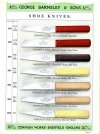
Thanks for the kind words my friend


I'll just add a bit more Lambsfoot content

One of the knives I'm carrying today


Actually, I'm in talks with Michael May to have a Barlow lambsfoot made for me. I'm quite excited at the prospect.
 I hope you get something nice
I hope you get something nice 

